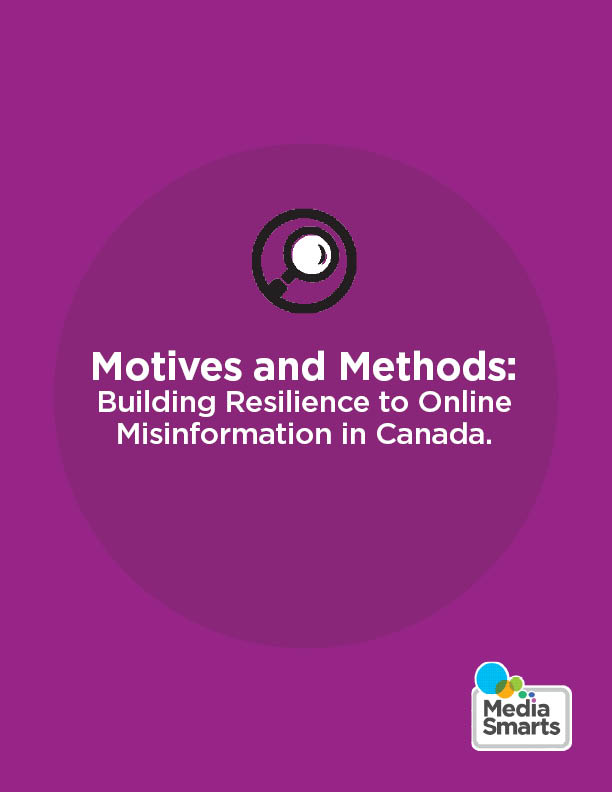Motives and Methods: Building Resilience to Online Misinformation in Canada

MediaSmarts designed the Motives and Methods research project to better understand how Canadians check and share information online, and to find the best ways to help them recognize and respond to online misinformation.
This study builds on MediaSmarts' successful Break the Fake (BTF) program, which teaches Canadians how to verify information. For this project, we developed five new BTF videos that address new challenges, like deepfakes. The videos covered why it’s important to verify information (motives) and how to do it (methods).
For more information:
The study, funded by Canadian Heritage, used mixed-methods conducted over two phases: a survey of 5,000 Canadians and interactive focus groups.
The survey looked at how participants’ fact-checking changed after watching a BTF video, as well as their opinions on the video’s accessibility, relevance and impact. It also explored their motivations for sharing information, how often they fact-check and how confident they feel in their abilities.
The focus groups offered deeper insights into patterns, themes and demographic differences that surfaced after the survey. One focus group specifically looked at older adults (55+), who are often more vulnerable to misinformation.
Based on these findings, we provide recommendations for designing effective video interventions that build citizen resilience to misinformation in Canada.
What we found
Difficulty with discernment: Most participants struggled to distinguish true from false information, often relying on intuition or guesswork.
Source reliability: Participants were more likely to trust information if it came from well-known publications, experts or reliable friends.
Lack of awareness of fact-checking tools: Many participants thought fact-checking tools were hard to find, with most not knowing about relatively popular tools like Snopes.
Misinformation paradox: Despite believing they were good at spotting misinformation, participants felt overwhelmed by the fact-checking process and the majority struggled to tell if information was true or not.
Visual misinformation (like deepfakes): While just under half of participants said they believed they could identify AI-generated images online, many struggled to do so in the exercises, mistaking fake images for real ones.
Older adults (55+): Older adults were more likely to believe false information and were less confident in their ability to identify false content compared to younger participants.
Sharing habits: Most participants didn't regularly share content online, but those who did said they checked its accuracy before sharing.
Recommendations for creating videos about fact-checking
Here are some things to keep in mind when creating video content addressing misinformation and teaching fact-checking, based on our research:
Treat visual misinformation as distinct: Focus on visual misinformation separately from text-based misinformation.
Positive messaging: Reassure individuals that they don’t need to be experts to identify visual misinformation, while acknowledging how it can feel overwhelming.
Avoid ‘hacks’: Don’t rely on methods like zooming in on images or measuring the amount of blinking in a video, as these ‘tells’ can become outdated.
Video accessibility: Keep videos under 60 seconds, use clear language and focus on one key message, especially for older adults.
Relatable scenarios: Share personal stories and real examples to help individuals, particularly older adults, feel reassured and not alone in the fact-checking process.
- Prompt people to reconsider their ability to distinguish true from false information and acknowledge their own biases and limitations.
Address the misinformation paradox: Recognize that while people often think they’re good at telling what’s true online, they still express overwhelm and limited knowledge when it comes to fact-checking.
Teach information triage: Stress that not every piece of information individuals come across online needs to be fact-checked. Instead, people can prioritize what to fact-check based on its relevance, sense of importance and urgency.
Wider recommendations
MediaSmarts recommends the following systemic approaches based on this research:
Ongoing research: Conduct consistent research to match the pace at which the online information landscape, and misinformation, evolves.
Platforms: Hold platforms accountable for improving the quality of information circulated online (including in the development and use of fact-checking tools).
Government: Develop and implement a national action plan for digital media literacy education, which is crucial to the life-long learning needed for building resilience to misinformation.
Cross-sector collaboration: Foster knowledge exchange and collaboration amongst community organizations and other key stakeholders (researchers, industry, policymakers, etc.) that serve the needs of a diverse Canadian population to amplify the impact of digital media literacy interventions.
Digital media literacy is essential for empowering Canadians to navigate online information, combat misinformation and make informed decisions. This project provides evidence-based strategies for researchers, educators and policymakers to enhance Canadians fact-checking and critical thinking skills.
